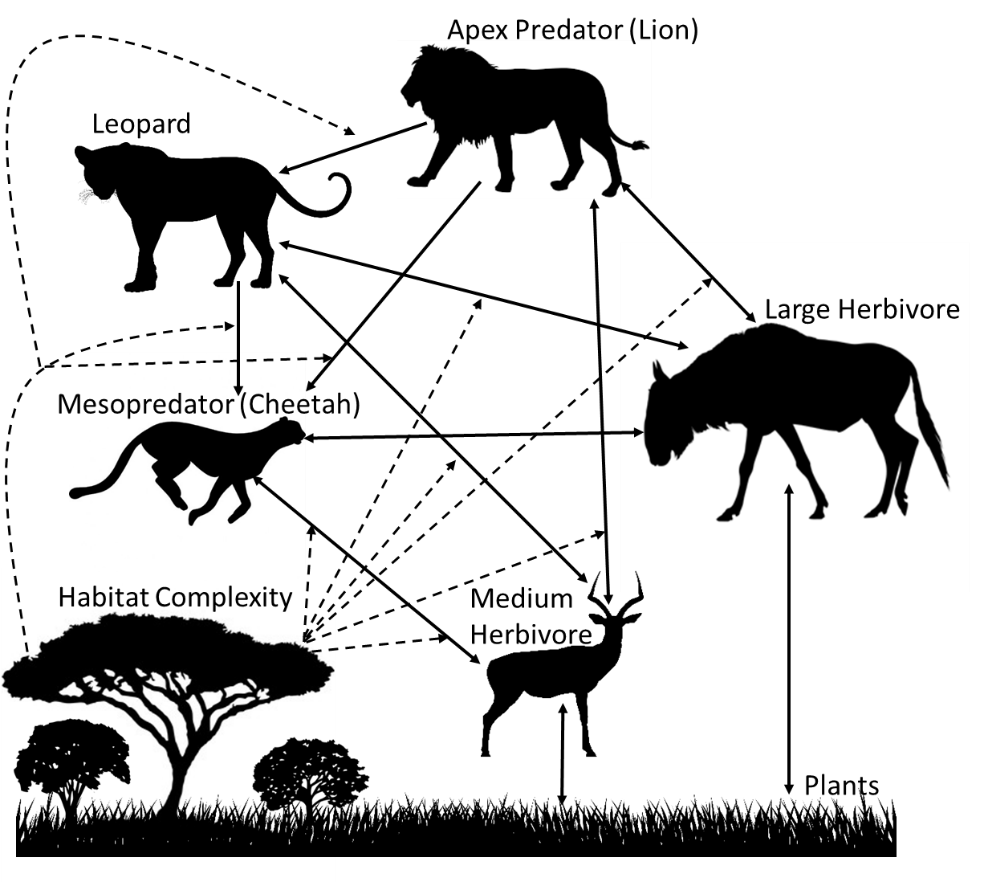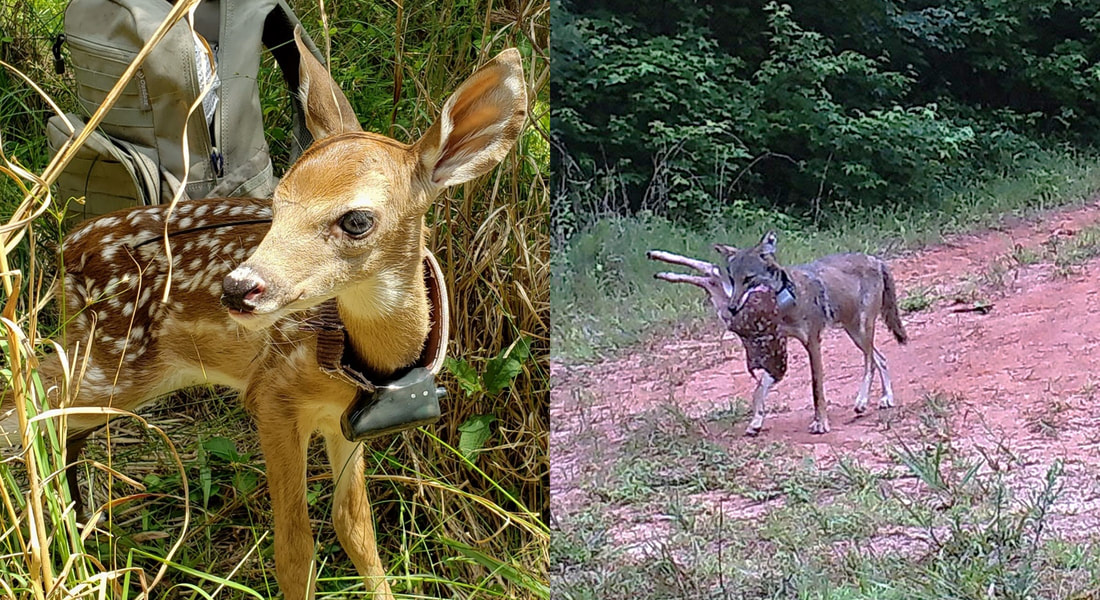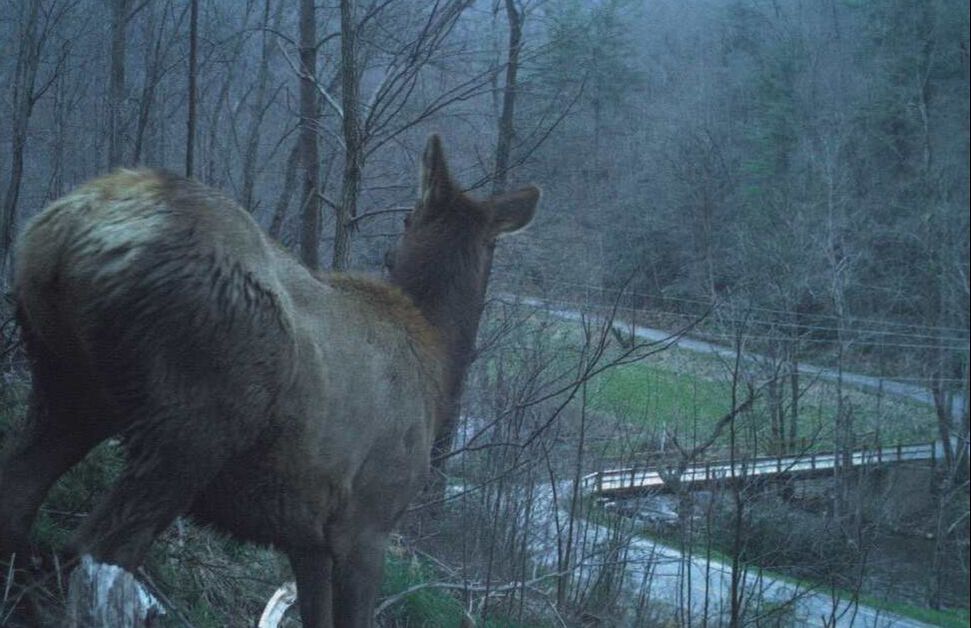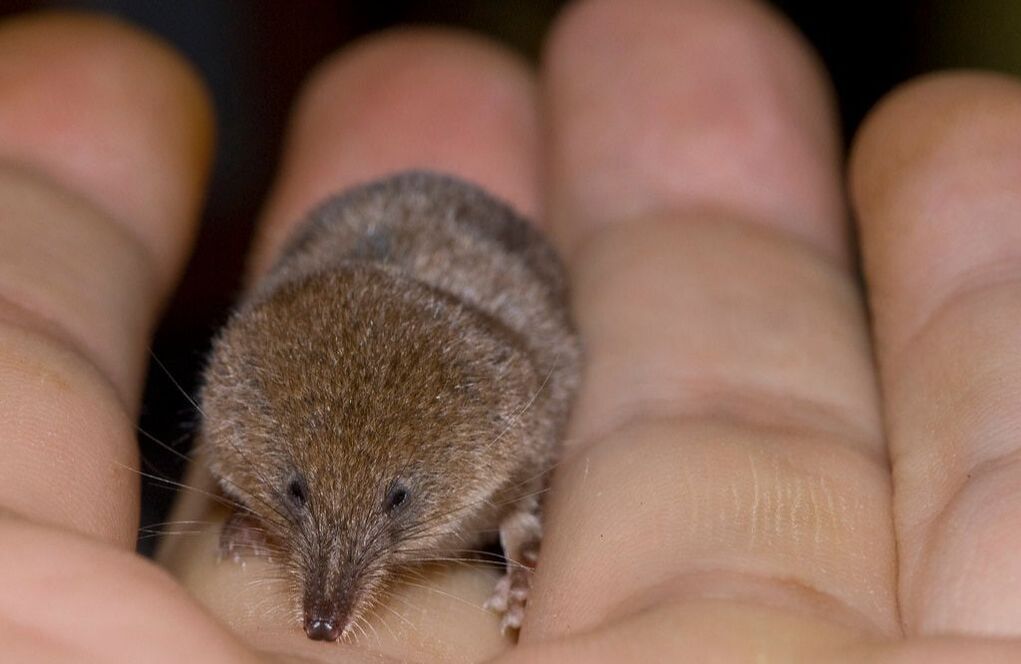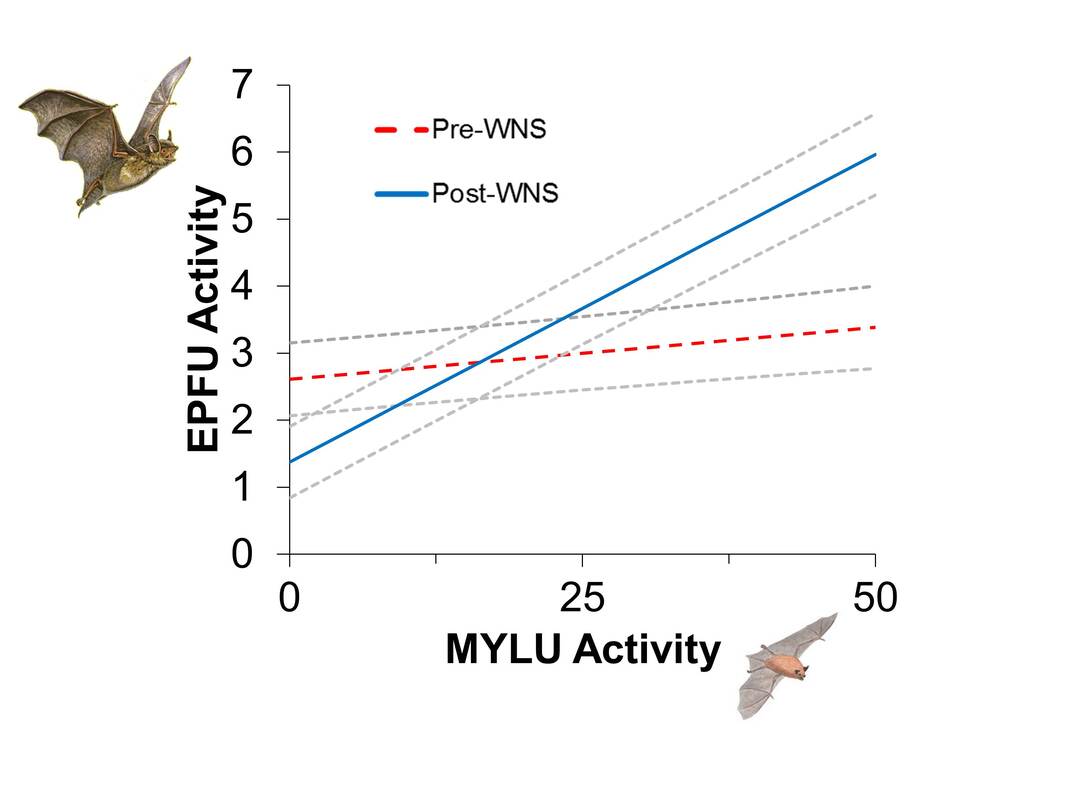CURRENT RESEARCH
Carnivore community dynamicsCarnivores are fascinating species that play important roles in ecosystems, while also being highly sensitive to environmental change. For some species like coyotes, populations of these moderately sized carnivores are rapidly expanding. At the same time, some species have been extirpated or are on the decline. We are not only interested in the ecology these species individually, but how they interact and impact ecosystem function at the community level.
We are currently assessing carnivore community ecology across several scales. Regionally we have been working with collaborators using large-scale camera trapping datasets (and other data sources) to predict the current and future distribution and composition of carnivore communities in response to global change. Locally, we are using long-term camera trap and radio-telemetry studies, in addition to experimental approaches, to evaluate how global change is likely influencing the structure and function of carnivore communities in the southeastern US and Africa. Project collaborators: US Geological Survey, North Carolina Wildlife Resources Commission, Virginia Tech, South Carolina Department of Natural Resources, Eastern Band of the Cherokee Indians, U.S. Forest Service Related Popular Articles:
The middle-out ecology movement - Animal Ecology in Focus Community-level responses of African carnivores to prescribed burning - The Applied Ecologist Herbivores, lions in South Africa exploit fire benefits - The Wildlife Society |
Related Recent Scientific Papers:
Jachowski, D.S., C.J. Marneweck, C. Olfenbuttel, and S.N. Harris. 2024. Support for the size-mediated sensitivity hypothesis within a diverse carnivore community. Journal of Animal Ecology 93:109-122. (Nice research highlight about our article here) Gigliotti, L., R. Slotow, C. Sholto-Douglas, C. de Vos and D.S. Jachowski. 2022. Community-level responses of African carnivores to prescribed burning. Journal of Applied Ecology. 59:251-262. Marneweck, C., T. Katzner, and D.S. Jachowski. 2021. Predicted climate-induced reductions in scavenging in eastern North America. Global Change Biology 27:3383-3394. Gigliotti, L.C., R. Slotow, L.T.B. Hunter, J. Fattebert, C. Sholto-Douglas, and D.S. Jachowski. 2020. Habitat complexity and duration of predation risk influence mesopredator survival in a multi-predator system. Scientific Reports 10:17841 Gigliotti, L.C., R. Slotow, L.T.B. Hunter, J. Fattebert, C. Sholto-Douglas, and D.S. Jachowski. 2020. Context-dependency of top-down and bottom-up influence on cheetah demography. Journal of Animal Ecology 89:449-459 |
Deer-Coyote-Pig Ecology in the PiedmontIn the eastern US, few wildlife species are as popular and well studied as white-tailed deer. Despite this wealth of research, there remains great debate about the context-specific factors that drive differences in the number of deer on the landscape. In particular, the relatively recent arrival of coyotes to portions of the southeast has raised many concerns. A series of well publicized studies suggest that low fawn survival in a population of deer near Aiken, South Carolina was linked to coyote predation. However, we don't know if coyotes are having similar effects in other portions of the southeast where conditions vary. In 2018, in collaboration with state and federal biologists, we initiated a large multi-year study to investigate the demography and movement ecology of doe and fawn white-tailed deer in the Piedmont region of South Carolina. At the same time, we will be investigating the spatial ecology and behavior of coyotes and wild pigs in this system, providing a detailed understanding of this dynamic predator-prey relationship and the impact of these species on not only deer, but the entire mammalian community in this system. More information can be found here.
Project collaborators: South Carolina Department of Natural Resources, U.S. Forest Service, QDMA Popular press about this project:
Hunter gut piles subsidize coyotes and make other carnivores wary - The Wildlife Society Wild pigs complicate deer movement in hunting season. Here’s what to do. -National Deer Association National Deer Association podcast on initial findings from our study showing blackberries could be key to reducing fawn predation |
Related scientific papers:
Saldo, E.R., A.J. Jensen, M.S. Muthersbaugh, J.W. Butfiloski, J. Cantrell, C. Ruth, G.K. Yarrow, J.C. Kilgo and D.S. Jachowski. In press. Unintended consequences of wildlife feeders on native and nonnative large mammals. Journal of Wildlife Management. Jensen, A.J, M. Muthersbaugh, C.R. Ruth, J.W. Butfiloski, J. Cantrell, J. Adams, L. Waits, J.C. Kilgo and D.S. Jachowski. 2024. Resource pulses shape seasonal and individual variation in the diet of an omnivorous carnivore. Ecology and Evolution e11632. Jensen, A.J., E.A. Saldo, Z. Chapman, J.W. Butfiloski and D.S. Jachowski. 2023. Risk from a top predator and forest structure influences scavenging by smaller carnivores. Ecosphere 14:e4596. Saldo, E.R., A.J. Jensen, M.S. Muthersbaugh, J.W. Butfiloski, J. Cantrell, J.C. Kilgo, C. Ruth, G.K. Yarrow and D.S. Jachowski. 2023. Spatiotemporal overlap with invasive wild pigs (Sus scrofa) varies by species and season. Ecosphere 14:e4500. Jensen, A., C. Marneweck, J. Kilgo, and D.S. Jachowski. 2022. Dietary plasticity of a rapidly expanding carnivore: Coyotes in North America. Mammal Review 52:480-496. |
Roads as barriers to mammal movementIn 2023 we started 2 new projects related to roads and their impact on species ranging from elk and bears, to weasels and mice. One project is based within the Qualla Boundary of the Eastern Band of the Cherokee Indians, which the famous Blue Ridge Parkway bisects and potentially influences animal movement.
The other project involves a diverse group collaborators in North Carolina involved with long-term monitoring of wildlife use of structures along Interstate 26 and Interstate 40 through the Smokey Mountains. Here most attention is placed on large mammals like elk and bears, but comparatively less is known about how these structures benefit smaller mammals. We are conducting research to investigate how roads and road crossing structures influence mesocarnivore movement along interstates in North Carolina. Project collaborators: National Park Association, Eastern Band of the Cherokee Indians, National Parks Association, Wildlands Network, North Carolina Wildlife Resources Commission
|
|
Small mammal community ecologyIn 2024 we started research on the ecology of high elevation mammal communities within southern Blue Ridge Mountains of South Carolina. This region is a plant and animal biodiversity hotspot in North America that has been identified as the top priority area for conservation action in the US. We are trying to fill natural history, distribution, and community ecology knowledge gaps about a suite of small mammals (shrews, moles, voles, mice, woodrats, spotted skunks and weasels) of high conservation concern.
We are also working with the state of North Carolina on multi-year project on small mammals associated with high elevation rocky outcrops - with a focus on woodrats. Project collaborators: South Carolina Department of Natural Resource, North Carolina Wildlife Resources Commission. |
Ecology of remnant bat communitiesWe are working with Dr. Susan Loeb of the U.S. Forest Service and other collaborators across the eastern U.S. on a variety of issues concerning bat behavior, population and community ecology, and long term monitoring in the eastern US. A primary focus of our work is the impact of white-nose syndrome on bat populations and communities.
In the Southeastern US, we are working to evaluate strategies for monitoring increasingly imperiled bat species at the landscape level. The Southeastern Bat Hub is located at Clemson University where we assist states in the region with implementing, reporting and analyzing data collected under the North American Bat Monitoring Program (NABat). Clemson is home to the Southeast Bat Hub for NABat monitoring. We also conduct focused studies on the ecology of individual species of conservation concern. An ongoing focus of our work on white-nose syndrome is at the bat community level, where we are studying the complex spatial and temporal shifts in bat community assembly following arrival of white-nose syndrome. In 2016, we initiated a region-wide study to evaluate how bat communities across the eastern US differentially respond to exposure to the disease. This research addresses fundamentally important ecological questions about species plasticity, niche shifts, and the impact of emerging infectious diseases on conspecific species behavior with different life-history traits (e.g., species that migrate vs. species that reside overwinter in hibernacula and are thus exposed to the disease). Project Collaborators: U.S. Forest Service, U.S. Fish and Wildlife Service, U.S. Geological Survey, Virginia Tech, South Carolina Department of Natural Resources, National Park Service |
Recent Related Scientific Papers:
Newman, B.A., S.C. Loeb, and D.S. Jachowski. 2024. Thermally unstable roosts influence winter patterns in a threatened bat species. Conservation Physiology 12:coae014. Sirajuddin, P., S.C. Loeb, E.R. Britzke, and D.S. Jachowski. In press. Winter torpor patterns of tri-colored bats (Perimyotis subflavus) in the southeastern U.S. Journal of Mammalogy. Bombaci, S.P., M.J. St. Germain, W.M. Ford, S.C. Loeb, R.E. Russell, C.A. Dobony, and D.S. Jachowski. 2021. Context dependency of disease-mediated competitive release in bat communities following white-nose syndrome. Ecosphere e03825. Newman, B.A., S.C. Loeb, and D.S. Jachowski. 2021. Winter roosting ecology of tri-colored bats (Perimyotis subflavus) in trees and bridges. Journal of Mammalogy 102:1331-1341. Shute, K.E., S.C. Loeb, and D.S. Jachowski. 2021. Summer roosting ecology of northern yellow bat and tri-colored bat in coastal South Carolina. Southeastern Naturalist 20:459-476. Shute, K.E., S.C. Loeb, and D.S. Jachowski. 2021. Seasonal shifts in nocturnal habitat use by coastal bat species of conservation concern. Journal of Wildlife Management 85:964-978. |
Proudly powered by Weebly
